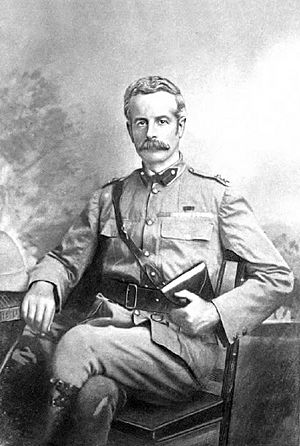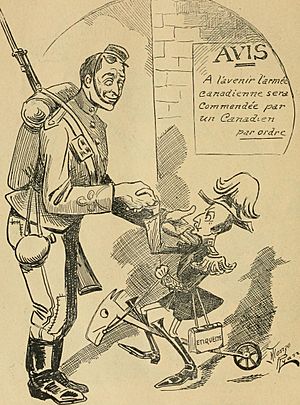Douglas Cochrane, 12th Earl of Dundonald facts for kids
Quick facts for kids
The Earl of Dundonald
|
|
|---|---|

Lord Dundonald in 1904
|
|
| Personal details | |
| Born | 29 October 1852 Banff, Scotland |
| Died | 12 April 1935 (aged 82) Wimbledon, England |
| Spouses |
Winifred Bamford-Hesketh
(m. 1878; |
| Relations | Thomas Cochrane, 1st Baron Cochrane of Cults (brother) |
| Children | 5, including Thomas |
| Parents | Thomas Cochrane, 11th Earl of Dundonald Louisa Harriet Mackinnon |
| Education | Eton College |
| Signature | |
| Military service | |
| Allegiance | |
| Branch/service | |
| Rank | Lieutenant General |
| Commands | General Officer Commanding the Militia of Canada 2nd Regiment of Life Guards |
| Battles/wars | Mahdist War Second Boer War First World War |
| Awards | Mentioned in Despatches (7) |
Lieutenant General Douglas Mackinnon Baillie Hamilton Cochrane, 12th Earl of Dundonald (born October 29, 1852 – died April 12, 1935) was a Scottish nobleman and a high-ranking officer in the British Army. He was known as Lord Cochrane from 1860 until 1885. He also served as a special representative for Scotland in the British Parliament for many years.
Contents
Douglas Cochrane: A Life of Service
Early Years
Douglas Cochrane was born in Banff, Scotland. He was the second son of Thomas Cochrane, the 11th Earl of Dundonald. His mother was Louisa Harriet Mackinnon. Douglas had a younger brother named Thomas Cochrane, who later became the 1st Baron Cochrane of Cults. Douglas went to a famous school called Eton College.
Military Adventures
Douglas Cochrane began his military career in July 1870. He joined a special army unit called the Life Guards. He quickly moved up the ranks, becoming a lieutenant in 1871 and a captain in 1878.
He took part in several important military actions. These included the Nile Expedition and the Relief of Khartoum in 1885. In 1895, he became the leader of the 2nd Life Guards.
Douglas Cochrane also served in the Second Boer War in South Africa. In November 1899, he was put in charge of the Mounted Brigade. This group was part of the South Natal Field Force. He helped in the Relief of Ladysmith in February 1900.
Serving in Canada
In April 1902, Lord Dundonald was chosen for a very important job. He became the General Officer Commanding the Militia of Canada. This meant he was the top military officer in Canada. He arrived in Quebec and Ottawa in July 1902 to start his new role.
While in Canada, he helped change the uniforms of many Scottish regiments. He wanted them to look more like their traditional Scottish culture. He served in Canada for two years. However, he was later asked to leave his position. This happened after a public disagreement with government officials about military matters. He believed that communication issues had left Canada's defenses weak.
In 1910, Douglas Cochrane was given a special role for king George V. He was appointed the first 'gold stick in waiting'. He also served as the king's 'aide de camp' when Theodore Roosevelt visited. Later, during the First World War, he helped lead the Admiralty Committee on Smoke Screens in 1915.
Clever Inventions
Lord Dundonald was also an inventor! He patented several useful items. Here are some of his inventions:
- 'Pocket-stove' (patented 1896)
- 'Carriage and Traction Arrangement for a Machine or Quick Firing Gun' (patented 1896)
- 'An Improvement in Nosebags for Horses' (patented 1896)
- 'Improvements in Horse Traction Arrangements for Vehicles' (patented 1897)
- 'Improvements in Ambulances and other Vehicles, especially adapted for Camel Traction' (patented 1897)
- 'Ammunition holder for machine guns' (patented 1898)
- 'Bicycle saddle'; a special seat for bicycles (patented 1898)
- 'Apparatus for Mechanical Patrontilførlsen by Guardian'; a cartridge supply system (patented 1899)
- 'Improvements in the Coupling and Traction of Bicycles' (patented 1899)
- 'Tea or Coffee pot'; this was a very popular invention! It was later made by the Wedgwood company and called the "SYP" (Simple Yet Perfect) teapot. (patented 1901)
Family Life
Lord Dundonald married Winifred Bamford-Hesketh in 1878. They lived for many years at Gwrych Castle in North Wales. Winifred did not go with her husband to Canada when he was stationed there.
They had five children together:
- Lady Grizel Winifred Louisa Cochrane (1880–1976)
- Thomas Hesketh Douglas Blair Cochrane, 13th Earl of Dundonald (1886–1958), who became a Captain in the Scots Guards.
- Lady Jean Alice Elaine Cochrane (1887–1955)
- Lady Marjorie Gwendoline Elsie Cochrane (born 1889)
- Hon. Douglas Robert Hesketh Roger Cochrane (1893–1942)
His wife, Winifred, passed away in January 1924. Lord Dundonald himself died at his home in Wimbledon in April 1935, when he was 82 years old. His eldest son, Thomas, became the next Earl of Dundonald. Lord Dundonald is buried in Achnaba Churchyard in Scotland.
Recognitions and Legacy
Lord Dundonald received several important honors for his service. In December 1901, he was made a Commander of the Royal Victorian Order (CVO). Then, in June 1907, he was knighted as a Knight Commander (KCVO) of the same order.
A park in Centretown, Ottawa, Canada, is named after him. It is called Dundonald Park.
See also


